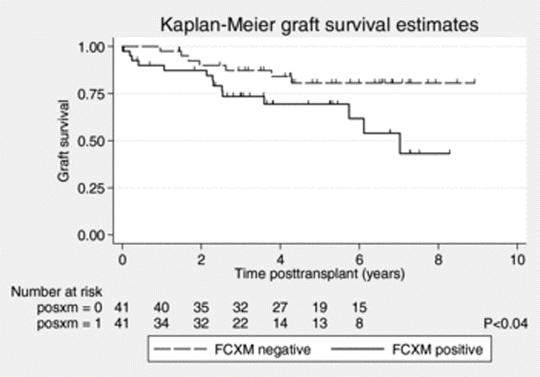Fig. 5.1
University of Maryland alloantibody removal protocol for live donor kidney recipients who have a positive crossmatch with their donor

Fig. 5.2
Graft survival in positive crossmatch cases compared with controls

Fig. 5.3
Graft survival in positive crossmatch group in those who achieved negative crossmatch versus those with persistently positive flow crossmatch at the time of transplant following course of desensitization
Future Directions
If regimen of administering IVIG to patients on the transplant wait list (such as those protocols of monthly infusions with dialysis described above) is found to be effective, logistically feasible, cost-effective in clinical practice, then perhaps this could be an option for highly sensitized kidney transplant candidates who are unable to find a living donor. Also, given the evidence that chimerism or microchimerism may be involved in the genesis of sustained sensitization and given the inability to produce long-term suppression of sensitization with our current regimens, some authors have suggested that actively eliminating chimerism in sensitized patients may provide an alternative strategy to control alloimmunization [31]. Immunopotentiating agents such as interferon or administration of antibodies with specificity of chimeric HLA are two strategies that could be employed in the near future.
References
1.
Patel R, Terasaki PI. Significance of the positive crossmatch test in kidney transplantation. N Engl J Med. 1969;280:735–9.PubMed
2.
Iwaki Y, Igurio T, Terasaki PI. Effect of sensitization on kidney allografts. In: Terasaki PI, editor. Clinical Transplants 1985. Los Angeles: UCLA Tissue Typing Laboratory; 1986. p. 139.
3.
Sayegh MH, Colvin RB. Case 8–2003: A35-year-old man with early dysfunction of a second renal transplant. N Engl J Med. 2003;348:1033–44.PubMed
4.
Cecka JM. The UNOS Scientific Renal Transplant Registry—2000. Clin Transpl 2000;1–18
5.
UNOS data: Scientific Registry of Transplant Recipients: Transplant Data 1988–2012. Department of Health and Human Services, Health Resources and Services Administration, 15 June 2012. Web. 25 June 2012. http://optn.transplant.hrsa.gov
6.
Iwaki Y, Terasaki PI. Sensitization effect. In: Terasaki PI, editor. Clinical kidney transplants 1986. Los Angeles: UCLA Tissue Typing Laboratory; 1987. p. 257 (“Organ Procurement and Transplantation Network.” United States Department of Health and Human Services).
7.
Pelletier RP, Hennessy PK, Adams PW, et al. High incidence of donor-reactive delayed-type hypersensitivity in transplant patients. Am J Transplant. 2002;2(10):926–33.PubMed
8.
Norman DJ. Clinical immunogenetics. In: Norman DJ, Turka LA, editors. Primer on transplantation. 2nd ed. Mt. Laurel: American Society of Transplantation; 2001. p. 51–9.
9.
Katznelson S, Bhaduri S, Cecka JM. Clinical aspects of sensitization. In: Cecka JM, Terasaki PI, editors. Clinical transplants 1997. Los Angeles: UCLA Tissue Typing Laboratory; 1998. p. 285–96.
10.
Ogura K. Sensitization. In: Terasaki PI, Cecka JM, editors. Clinical transplants 1992. Los Angeles: UCLA Tissue Typing Laboratory; 1993. p. 357.
11.
Cardella CJ, Falk JA, et al. Successful renal transplantation in patients with T-cell reactivity to donor. Lancet. 1982;2:240.
12.
Chapman JR. A different view of sensitization after transplant rejection? (editorial). Transplantation. 2001;71(7):825–6.PubMed
13.
Crespo M, Pascual M, Tolkoff-Rubin N, et al. Acute humoral rejection in renal allograft recipients. I. Incidence, serology and clinical characteristics. Transplantation. 2001;71:652–8.PubMed
14.
Mauiyyedi S, Crespo M, Collins AB, et al. Acute humoral rejection in kidney transplantation. II. Morphology, immunopathology, and pathologic classification. J Am Soc Nephrol. 2002;13:779–87.PubMed
15.
Halloran PF, Wadgymar A, Ritchie S, Falk J, Solez K, Srinivasa NS. The significance of the anti-class I antibody response. I. Clinical and pathologic features of anti-class I-mediated rejection. Transplantation. 1990;49:85–91.PubMed
16.
Halloran PF, Schlaut J, Solez K, Srinivasa NS. The significance of the anti-class I response. II. Clinical and pathologic features of renal transplants with anti-class I-like antibody. Transplantation. 1992;53:550–5.PubMed
17.
Bohmig GA, Exner M, Watschinger B, Regele H. Acute humoral renal allograft rejection. Curr Opin Urol. 2002;12:95–9.PubMed
18.
McKenna RM, Takemoto SK, Terasaki PI. Anti-HLA antibodies after solid organ transplantation. Transplantation. 2000;69(3):319–26.PubMed
Stay updated, free articles. Join our Telegram channel

Full access? Get Clinical Tree







